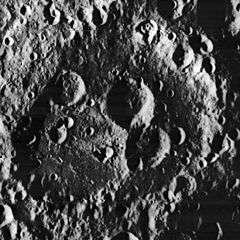Galois (crater)
|
Lunar Orbiter 1 image | |
| Coordinates | 14°12′S 151°54′W / 14.2°S 151.9°WCoordinates: 14°12′S 151°54′W / 14.2°S 151.9°W |
|---|---|
| Diameter | 222 km |
| Depth | Unknown |
| Colongitude | 156° at sunrise |
| Eponym | Évariste Galois |
Galois is a large lunar crater on the far side of the Moon. Features of this class are commonly termed walled plains, due to their appearance and dimension. It is located just to the southeast of another huge walled plain, Korolev, a formation nearly double the diameter of Galois. Several hundred kilometers due south is another enormous feature, Apollo.
This is a heavily eroded feature with a rim that has been reshaped by impacts, particularly along the northwest edge where it lies near Korolev. An influx of material forms an inward bulge along the southern edge, which is impacted by Galois Q. The interior floor is also overlain by several notable craters, with the craters Galois A and Galois L forming a nearly matching pair near the midpoint. Along the northeastern rim are Galois B and Galois C, while Galois U lies against the northwestern inner wall. The most intact and nearly level section of floor is along the southwestern part of the interior.
A small, unnamed impact crater located along the northeastern rim of Galois has a relatively high albedo and lies at the focus of a small ray system. The rays from this impact are the most prominent to the north, where they cross the floor of the crater Mechnikov. Craters that have a ray system are considered indicative of a relatively recent impact, as the rays are steadily erased by space weathering.
Satellite craters
By convention these features are identified on lunar maps by placing the letter on the side of the crater midpoint that is closest to Galois.
| Galois | Latitude | Longitude | Diameter |
|---|---|---|---|
| A | 14.0° S | 152.5° W | 54 km |
| B | 11.3° S | 151.8° W | 20 km |
| C | 12.4° S | 150.5° W | 22 km |
| F | 13.9° S | 146.4° W | 13 km |
| H | 15.2° S | 150.9° W | 19 km |
| L | 15.5° S | 152.0° W | 51 km |
| M | 16.1° S | 152.4° W | 18 km |
| Q | 15.2° S | 154.7° W | 132 km |
| S | 14.5° S | 154.9° W | 18 km |
| U | 13.2° S | 154.7° W | 35 km |
-

Oblique view of Galois A
References
- Andersson, L. E.; Whitaker, E. A. (1982). NASA Catalogue of Lunar Nomenclature. NASA RP-1097.
- Blue, Jennifer (July 25, 2007). "Gazetteer of Planetary Nomenclature". USGS. Retrieved 2007-08-05.
- Bussey, B.; Spudis, P. (2004). The Clementine Atlas of the Moon. New York: Cambridge University Press. ISBN 978-0-521-81528-4.
- Cocks, Elijah E.; Cocks, Josiah C. (1995). Who's Who on the Moon: A Biographical Dictionary of Lunar Nomenclature. Tudor Publishers. ISBN 978-0-936389-27-1.
- McDowell, Jonathan (July 15, 2007). "Lunar Nomenclature". Jonathan's Space Report. Retrieved 2007-10-24.
- Menzel, D. H.; Minnaert, M.; Levin, B.; Dollfus, A.; Bell, B. (1971). "Report on Lunar Nomenclature by the Working Group of Commission 17 of the IAU". Space Science Reviews. 12 (2): 136–186. Bibcode:1971SSRv...12..136M. doi:10.1007/BF00171763.
- Moore, Patrick (2001). On the Moon. Sterling Publishing Co. ISBN 978-0-304-35469-6.
- Price, Fred W. (1988). The Moon Observer's Handbook. Cambridge University Press. ISBN 978-0-521-33500-3.
- Rükl, Antonín (1990). Atlas of the Moon. Kalmbach Books. ISBN 978-0-913135-17-4.
- Webb, Rev. T. W. (1962). Celestial Objects for Common Telescopes (6th revised ed.). Dover. ISBN 978-0-486-20917-3.
- Whitaker, Ewen A. (1999). Mapping and Naming the Moon. Cambridge University Press. ISBN 978-0-521-62248-6.
- Wlasuk, Peter T. (2000). Observing the Moon. Springer. ISBN 978-1-85233-193-1.
